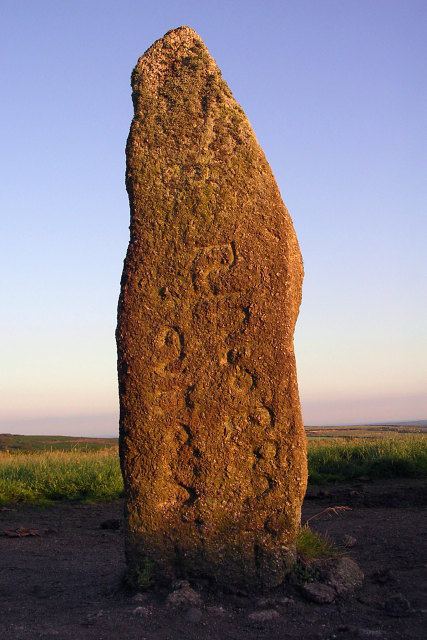Periods Early middle ages | Type Standing stone | |
 | ||
Similar Mên‑an‑Tol, Chûn Quoit, Lanyon Quoit, Zennor Quoit, Chûn Castle | ||
Mên Scryfa (or Mên Scrifa, literally "stone with writing") is an inscribed standing stone in Cornwall, United Kingdom (grid reference SW427353). The inscription, dating to the early medieval period, commemorates "Rialobranus son of Cunovalus."
Contents
Location
Mên Scryfa stands near the Madron to Morvah road in Cornwall. It stands in the middle of a field. The prehistoric Mên-an-Tol standing stones lie about 300 metres to the south.
Description
The stone is 1.7 metres high and roughly rectangular in section, with sides of 0.4 metres by 0.5 metres. The inscription is on the northern face, although the bottom of the inscription is buried in the ground. At one time two plain crosses were said to be viewable at the upper end of the stone. The horizontal axis of the lower cross, is clearly visible but the vertical stroke is very indistinct. The smaller cross above this can no longer be distinguished.
The inscription
The inscription, in debased Roman capitals, reads "Rialobrani Cunovali fili", which translates as "Rialobranus son of Cunovalus." Rialobran is not known elsewhere, but he may have been a Cornish petty king or tribal leader. Rialobran (or Ryalvran) may be Cornish for "royal raven", whereas Cunovallos may be British for "famous leader", thus the inscription would read "royal raven son of famous leader. Antiquarians, at one time, used to identify Cunovalus with the pre-Roman British king Cunobeline.
Dating
The inscription has been dated on stylistic grounds to the 6th to 8th century AD. It is thought, however, that the stone itself could be a prehistoric standing stone.
History
The antiquarian William Borlase described the stone in 1769: at that time it was lying prostrate on the ground. It was erected in 1825 only to be toppled again in 1849 by treasure hunters. It was lying face down when John Thomas Blight described it in 1861. It was however re-erected in its current position around 1862, the last word of the inscription being buried.
In folklore
A popular tradition stated that a battle was fought nearby, and that Riolbranus was slain and buried at the spot. It was further claimed that the length of the stone (about 9 feet) was the exact height of the warrior.
